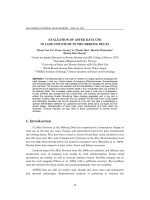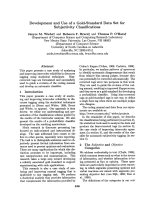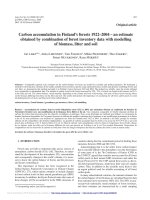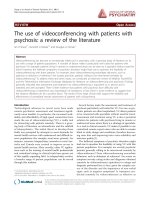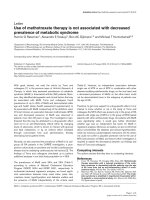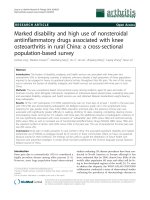measuring construct with use of survey data
Bạn đang xem bản rút gọn của tài liệu. Xem và tải ngay bản đầy đủ của tài liệu tại đây (1.79 MB, 11 trang )
<span class="text_page_counter">Trang 1</span><div class="page_container" data-page="1">
<b>Survey Method - Final ProjectMEASURING CONSTRUCTWITH USE OF SURVEY DATA</b>
<i>Describe existing measure based on the research Factors influencing Chineseresidents’ post-pandemic outbound travel intentions: an extended theory of plannedbehaviour model based on the perception of COVID-19. Liu, Y., Shi, H., Li, Y., &</i>
<i>Amin, A. (2021). doi.org/10.1108/tr-09-2020-0458</i>
Hoang Lang 128822
Warszawa, 09.02.2024
</div><span class="text_page_counter">Trang 2</span><div class="page_container" data-page="2">Table of Contents
5. Evaluate existing measure form perspective of validity and reliability of measurement 7
6. Discuss studied construct. What are the pros and cons of using multiple questions in order to measure constructs in terms of validity and reliability 8
</div><span class="text_page_counter">Trang 3</span><div class="page_container" data-page="3"><b>1. Introduction</b>
The study titled "Post-pandemic outbound travel intentions: An extended theory of planned behaviour model" by Liu et al. (2020) aims to explore the factors influencing Chinese residents' intentions to participate in outbound travel after the COVID-19 pandemic. It utilizes an extended Theory of Planned Behavior (TPB) model and structural equation modeling to analyze data from 432 questionnaires gathered through online surveys and traditional paper-based distribution.
Key findings from the study include: (1) Factors Influencing Outbound Travel Intentions: Attitude, subjective norms, perceived behavioral control, and past outbound travel behavior have significant positive effects on post-pandemic outbound travel intentions among Chinese residents. (2) Role of COVID-19 Perception: The perception of COVID-19 directly and negatively influences outbound travel intentions. Additionally, it indirectly affects travel intentions through the mediating effect of non-pharmaceutical interventions. (3) Moderating Effect of Risk Tolerance: Risk tolerance negatively moderates the direct impact of residents' perception of COVID-19 on their travel intentions.
Practical implications of the study suggest that the findings can inform the formulation of appropriate tourism development policies by government agencies, tourism management departments, and tourism enterprises in destination countries.
The study's originality lies in its development of an extended TPB model by incorporating additional constructs, which enhances the explanatory power of post-pandemic travel intentions. Additionally, it provides evidence for the applicability of the TPB model in studying travel intentions within the context of major public health emergencies, thus expanding the model's application scope.
<b>2. Construct/ Research Model</b>
Each construct in the study measures a specific psychological or behavioral aspect related to the post-pandemic outbound travel intentions of Chinese residents. Here's what each construct measures:
1. Attitude (ATT): This construct measures individuals' overall positive or negative evaluations of traveling abroad post-pandemic. It assesses their subjective feelings and beliefs about the desirability, value, and enjoyment of engaging in outbound travel once the pandemic subsides.
2. Subjective Norms (SN): SN evaluates the influence of social pressure or perceived social norms on individuals' intentions to travel abroad post-pandemic. It examines the extent to which individuals believe that important others (e.g., family, friends, colleagues) expect or support their participation in outbound travel.
3. Perceived Behavioral Control (PBC): PBC assesses individuals' perceptions of their ability to control their outbound travel behaviour post-pandemic. It reflects their confidence in overcoming barriers or obstacles and their perception of having the necessary resources (e.g., time, money, confidence) to engage in travel.
4. Post-pandemic Outbound Travel Intention (PTI): This construct captures individuals' intentions, plans, or motivations to travel abroad after the pandemic. It reflects their willingness to take concrete steps towards engaging in outbound travel, such as making plans, allocating resources, or committing time and effort.
</div><span class="text_page_counter">Trang 4</span><div class="page_container" data-page="4">attitudes towards the COVID-19 pandemic. It encompasses various aspects such as perceived severity, fear, knowledge, and perceived risk associated with the disease.
6. Non-pharmaceutical Interventions (NPI): NPI evaluates individuals' willingness to adopt precautionary measures when traveling post-pandemic. It assesses their intentions or behaviors related to following recommended health and safety practices, such as seeking information, practicing hygiene, maintaining social distance, and wearing masks.
7. Risk Tolerance (RT): RT assesses individuals' propensity to tolerate risks associated with various aspects of travel, particularly in the context of the post-pandemic period. It reflects their comfort level with uncertainty, adventure, and potential negative outcomes related to
</div><span class="text_page_counter">Trang 5</span><div class="page_container" data-page="5">- ATT1: Measures the perception of the goodness of traveling abroad post-pandemic. - ATT2: Measures the perception of the value or worthiness of traveling abroad
- SN1: Measures the perception of the approval or encouragement from important people to travel abroad post-pandemic.
- SN2: Measures the perception of the understanding or acceptance from important people regarding traveling abroad post-pandemic.
- SN3: Measures the agreement or alignment of opinions with respected individuals regarding traveling abroad post-pandemic.
- SN4: Measures the perception of support or endorsement from respected individuals for traveling abroad post-pandemic.
- SN5: Measures the recommendation or advice from respected individuals to travel abroad post-pandemic.
3. Perceived Behavioral Control
- PBC1: Measures the perception of having enough time to travel abroad post-pandemic. - PBC2: Measures the perception of having enough financial resources to travel abroad post-pandemic.
- PBC3: Measures the confidence in one's ability to travel abroad post-pandemic. - PBC4: Measures the absence of perceived barriers or obstacles to traveling abroad post-pandemic.
4. Post-pandemic Outbound Travel Intention
- PTI1: Measures the desire or want to travel abroad after the pandemic.
</div><span class="text_page_counter">Trang 6</span><div class="page_container" data-page="6">- PTI3: Measures the concrete planning or preparation for traveling abroad after the
- PER1: Measures the perception of the severity or fearfulness of COVID-19. - PER2: Measures the comparison of COVID-19 with other diseases in terms of danger. - PER3: Measures the personal fear or anxiety related to COVID-19.
- PER4: Measures the level of information individuals have about COVID-19.
- PER5: Measures the perception of danger associated with traveling abroad due to COVID-19.
- PER6: Measures the observation of others' avoidance of traveling abroad due to COVID-19.
6. Non-pharmaceutical Interventions
- NPI1-NPI3: Measure the intention or willingness to seek information and prepare for traveling abroad regarding COVID-19.
- NPI4-NPI6: Measure the intention or willingness to adopt specific preventive measures during travel, such as hand hygiene, social distancing, and mask-wearing.
- NPI7: Measures the intention or commitment to monitor personal health after traveling abroad.
7. Risk Tolerance
- RT1: Measures the tolerance for financial risks. - RT2: Measures the engagement in adventurous activities. - RT3: Measures the perception of risk-taking by close friends. - RT4: Measures the preference for flexible and adventurous travel styles. - RT5: Measures the willingness to invest more in adventurous travel experiences.
<b>4. Data Requirements for Reliability and Validity</b>
- Use validated scales and measures whenever possible to ensure reliability and
- Consider collecting demographic data (age, gender, income, etc.) to explore possible variations in travel intentions.
</div><span class="text_page_counter">Trang 7</span><div class="page_container" data-page="7"><b>5. Evaluate existing measure form perspective of validity andreliability of measurement</b>
Based on the information provided by the researchers, their study use the quantitative method to assess various constructs influencing post-pandemic travel intentions. Hence, here's the evaluation from the perspective of reliability and validity.
First, the Strengths of Reliability are (1) Internal consistency: They used Likert-scale questions and validated scales whenever possible, which can enhance internal consistency. (2) Stability: Measuring past travel behavior might show stability over time, indicating consistent responses. (3) Comparability: Using standardized scales and consistent data collection methods can improve comparability between participants. The Weakness for Reliability can be figured out as Combining survey methods: Mixing online and paper surveys might introduce variability due to differences in accessibility and response formats. Online survey can higher the dropped out rate of respondents.
Secondly, the Strength of Validity are (1) Validated scales: Utilizing established scales for constructs like risk tolerance can improve construct validity. (2) Logical relationships: Exploring expected relationships between variables (e.g., Perception of COVID-19 and Non-pharmaceutical Interventions, Post-Pandemic Travel Intention, etc ) can support construct validity. Furthermore, the Weakness for Validity is most of those (1) Face validity: Some constructs (e.g., perception of COVID-19) might require further exploration using open-ended questions to ensure they capture participants' true understanding. (2) Criterion-related validity: While past travel behaviour might serve as a criterion, additional external measures like actual travel bookings could strengthen predictive validity.
The authors state that To ensure the content validity of the questionnaire, all items drew on the existing international literature and references. The items were designed in line with the COVID-19 pandemic, and relevant experts were invited to modify and polish the structure and statements of the scale so as to ensure that the questionnaire is easy to understand and answer. Further, to prove the reliability and validity of this study, the researchers do various kind of data test by the advantage of SPSS 20.0 and AMOS 23.0. to ensure the robustness of the measurement scales used, particularly considering the modification of some scales from the original literature. Cronbach's alpha coefficients and composite reliability (CR) were used to assess reliability. Cronbach's alpha coefficients for each variable ranged from 0.802 to 0.969, with an overall coefficient of 0.928, indicating high internal consistency. Composite reliability ranged from 0.872 to 0.972, surpassing the common standard of 0.7, demonstrating good reliability across the scale. Construct validity was tested using exploratory factor analysis (EFA) to assess the dimensionality of the scales. Kaiser-Meyer-Olkin (KMO) and Bartlett's test of sphericity indicated that the data were suitable for factor analysis (KMO = 0.927). Principal components analysis was used to extract seven common factors with eigenvalues greater than 1, explaining 79.633% of the variance. Factor loadings for each component were above 0.5, and there was no cross-loading, ensuring good scale validity. Confirmatory factor analysis (CFA) was employed to test convergent and discriminant validity. Standardized factor loadings and average extracted variance (AVE) of variables were examined. Factor loadings ranged from 0.599 to 0.967, exceeding the critical value of 0.5, and AVE was greater than 0.5 for all variables, indicating good convergent validity. Discriminant validity was confirmed by comparing the square root of AVE with the correlation coefficient between variables. The square root of AVE was greater than the correlation coefficient, suggesting good discriminant validity. Fitting indices of the CFA, including x2/df, root mean square error of approximation (RMSEA), comparative fit index (CFI), incremental fit index (IFI), and Tucker-Lewis index (TLI), all met the fitting standards, indicating a good fit
</div><span class="text_page_counter">Trang 8</span><div class="page_container" data-page="8">demonstrated high reliability and validity, providing confidence in the accuracy and integrity of the data collected for analyzing post-pandemic outbound travel intentions.
Overall, the research measures hold promise for both reliability and validity. However, tthere are areas for improvement such as using validated scales, combining qualitative and quantitative approaches, and addressing potential biases can enhance the overall quality of your data. Furthermore, we can include Pilot tesr to the instruments with a small sample to identify and address any issues before collecting large-scale data. We can think about for potential confounding variables that might influence travel intentions (e.g., age, income, health status). Hence, clearly define the constructs and operationalize them using appropriate measures. Document the data collection and analysis procedures transparently for better reliability and replicability.
<b>6. Discuss studied construct. What are the pros and cons ofusing multiple questions in order to measure constructs interms of validity and reliability</b>
Attitudes, subjective norms, perceived behavioral control, and post-pandemic outbound travel intentions were assessed using measurement scales derived from the Theory of Planned Behavior (TPB) model proposed by Ajzen (1991), drawing from the scales utilized by Lam and Hsu (2006) and Sparks and Pan (2009) in their TPB-based studies on tourist behavior. The questionnaire encompassed a total of 19 items across these four variables. Regarding the perception of COVID-19 and non-pharmaceutical interventions, inspiration was drawn mainly from the research of Lee et al. (2012) on the impact of the 2009 H1N1 pandemic on South Korean tourists' travel intentions. The questionnaire included six items to gauge respondents' perception of COVID-19, while non-pharmaceutical interventions were aligned with recommended personal protective behaviors to prevent COVID-19 transmission, such as mask-wearing, frequent handwashing, and maintaining social distance. The measurement scale utilized by Lee et al. (2012) underwent modification to incorporate a total of seven items on non-pharmaceutical interventions, encompassing increased disease awareness and actions promoting personal hygiene and health. Notably, there is presently no established scale for assessing risk tolerance. In addressing this, the study referenced the works of Williams and Balazˇ (2013) and Campara et al. (2017) to develop six items on risk tolerance, covering financial, general, and tourism-related risk tolerance. Items pertaining to past outbound travel behavior were informed by scales used in studies by Juschten et al. (2019) and Bentler and Speckart (1981). Notably, the sole item concerning individuals' past outbound travel behavior queried the frequency of foreign travel over the past five years. All variables, except for past outbound travel behaviour, were evaluated using a seven-point Likert scale, with "1" indicating strong disagreement and "7" indicating strong agreement.
This research mainly based on the Theory of Planned Behavior which already examine by Hugh amount of other researchers. However, as the authors want to extend the Theory, they combine more outside factor which lead to the fact that the constructs cover a wide range of psychological, social, and behavioural factors relevant to post-pandemic travel intentions, providing a comprehensive understanding of individuals' attitudes, perceptions, and intentions.VThe use of multiple-item scales for each construct enhances the depth and
</div><span class="text_page_counter">Trang 9</span><div class="page_container" data-page="9">First, the advantages are
1. Content Validity: Multiple questions allow researchers to assess different facets of a construct, providing a more comprehensive understanding of the phenomenon under study. This enhances content validity by ensuring that the measurement instrument captures the full range of meanings associated with the construct.
2. Reliability: By employing multiple items to measure a construct, researchers can assess the consistency of respondents' answers. This enhances reliability as it reduces the impact of random measurement error, providing more dependable results.
3. Construct Validity: Utilizing multiple questions enables researchers to confirm the validity of a construct by examining convergent and discriminant validity. Convergent validity is demonstrated when different questions intended to measure the same construct produce similar responses. Discriminant validity is established when questions designed to measure different constructs yield distinct responses.
4. Reduced Response Bias: Using multiple questions mitigates the risk of response bias, such as acquiescence bias or social desirability bias. Respondents are less likely to provide uniform responses to all items, leading to more accurate and unbiased data.
5. Robustness: Multiple questions help to ensure the robustness of findings by reducing the influence of outliers or measurement errors associated with individual items. Robust findings increase confidence in the results and their generalizability to the target population.
Secondly, the disadvantages can be named as:
1. Response Burden: Respondents may experience fatigue or cognitive overload when faced with numerous questions, leading to lower response rates or decreased data quality. This can compromise the reliability and validity of the data collected.
2. Complex Analysis: Analyzing data from multiple items for each construct can be complex and time-consuming, requiring more advanced statistical techniques for validation and interpretation. This complexity may pose challenges for researchers, particularly those with limited statistical expertise.
3. Potential Redundancy: Some questions may overlap in content, leading to redundancy in measurement and potentially inflating the instrument's length without adding substantial value. Redundant questions may also confuse respondents and introduce measurement error.
4. Difficulty in Interpretation: Interpreting results from multiple-item constructs requires careful consideration, as discrepancies or inconsistencies between items may arise. Researchers must address these discrepancies to ensure the validity and reliability of the measurement instrument.
<b>7. Conclusion</b>
In conclusion, the study by Liu et al. (2020) on post-pandemic outbound travel intentions among Chinese residents provides valuable insights into the factors influencing individuals' travel intentions in the aftermath of the COVID-19 pandemic. By utilizing an extended
</div><span class="text_page_counter">Trang 10</span><div class="page_container" data-page="10">study offers a comprehensive analysis of various psychological and behavioral constructs that shape post-pandemic travel intentions.
The study's originality lies in its development of an extended TPB model, which incorporates additional constructs to enhance the explanatory power of post-pandemic travel intentions. Furthermore, the study contributes to the broader literature by demonstrating the applicability of the TPB model in studying travel intentions within the context of major public health emergencies, thereby expanding the model's application scope.
Overall, the research underscores the complexity of post-pandemic travel behavior and the need for a multifaceted approach to understanding and addressing individuals' travel intentions in the wake of global health crises. By considering the interplay of psychological, social, and environmental factors, stakeholders can better adapt their strategies to meet the evolving needs and preferences of travelers in a post-pandemic world.
</div>